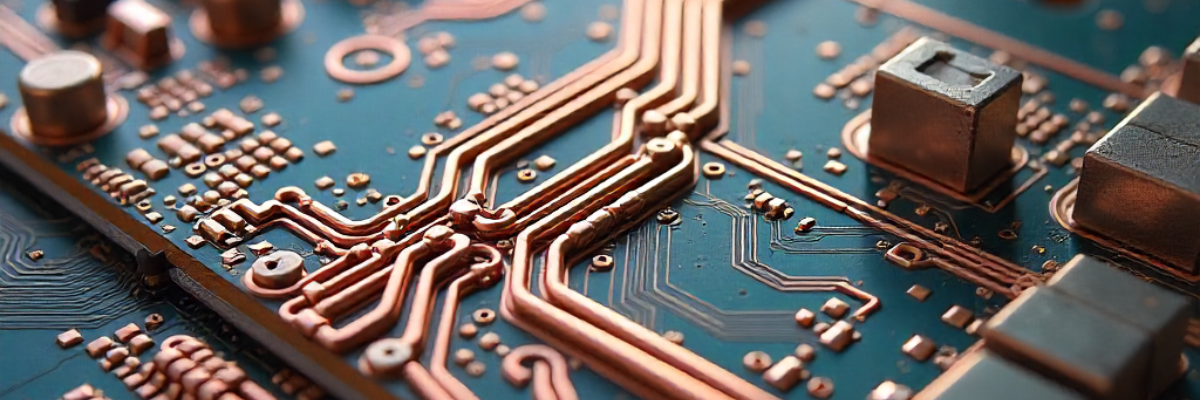Think about the power electronics in an electric vehicle (EV), the motor controllers, the battery management systems, and the charging circuits that all work together to ensure the vehicle runs smoothly. These systems are not only complex but also high-powered, constantly dealing with heat and electrical stress. So, how do we make sure everything operates reliably and efficiently? One of the key components that make this possible is the heavy copper PCB.
This post discusses about heavy copper PCBs, why they’re so essential for power electronics, how to design them effectively, and their key applications in industries that rely on high-current solutions.
What Are Heavy Copper PCBs?
Heavy copper PCBs are a type of printed circuit board that use copper layers significantly thicker than the standard range, typically from 3 oz to 10 oz per square foot, and in some cases, even thicker. The additional copper thickness allows these PCBs to handle higher electrical currents, improving their performance in high-power applications. These PCBs are ideal for industries where reliability, heat dissipation, and performance are crucial.
Advantages of Heavy Copper PCBs in High-Current Power Electronics
Heavy copper PCBs offer a range of benefits that make them the ideal choice for high-current power electronics. Below are the key advantages that set them apart.
- Improved Current Carrying Capacity: Heavy copper PCBs can manage much higher currents than standard PCBs, making them the preferred choice for power electronics, such as motor drives and power supplies. The thicker copper layers ensure lower resistance and allow for the safe flow of high currents, reducing the risk of overheating and failure.
- Greater Durability in Harsh Environments: These PCBs are built to withstand tough environments, including extreme temperatures and exposure to corrosive substances. This makes them highly suitable for applications in automotive systems, industrial equipment, and renewable energy technologies, where durability is a critical factor.
- Enhanced Heat Dissipation: Heat is a major concern in power electronics, and heavy copper PCBs are designed to address this issue. The thicker copper effectively spreads heat across the board, preventing localized overheating. This heat distribution ensures that components remain within safe operating temperatures, even under high current loads.
- Reduced Electrical Losses: With higher copper thickness, there is less resistance in the PCB, which reduces power loss. This is especially important in high-performance systems, such as power converters and amplifiers, where efficiency is key. Reduced electrical losses lead to greater energy efficiency and better overall system performance.
Key Design Considerations for Heavy Copper PCBs
Designing heavy copper PCBs involves several considerations that ensure the board can handle the increased power demands. Here are some important factors to keep in mind.
- Via and Hole Size: For heavy copper PCBs, vias need to be appropriately sized to handle the increased current flow. This ensures that electrical connections remain intact and heat is effectively spread across the PCB.
- Material Selection: Selecting the right base material is just as important as the copper thickness. Materials such as FR4, polyimide, or ceramic substrates are commonly used in heavy copper PCB designs owing to their excellent thermal and electrical properties. The choice of substrate affects the overall performance of the PCB in high-power applications.
- Copper Thickness Selection: The amount of copper used on the PCB is critical to its performance. Thicker copper allows the PCB to carry higher currents, but it’s essential to choose the correct thickness based on the specific power requirements of the application. Accurate calculation of copper thickness is key to ensuring that the PCB can handle the expected load.
- Thermal Management: Effective heat dissipation is essential in heavy copper PCBs. Additional thermal management features, such as heat sinks, thermal vias, or dedicated heat-spreading layers, can help manage the heat generated during high-current operations. Ensuring that the design includes proper thermal pathways will prevent thermal overload and component damage.
- Trace Width and Spacing: The width of the copper traces must be carefully calculated to ensure they can handle the required current without excessive heating. While thicker copper allows for wider traces, it’s essential to balance this with the overall size and layout of the PCB.
Common Applications of Heavy Copper PCBs
Heavy copper PCBs are used across a variety of industries that require high current handling and effective heat management. Some of the key applications include:
- Power Electronics: Heavy copper PCBs are widely used in power electronics, such as inverters, converters, and rectifiers.
- Automotive Electronics: In electric and hybrid vehicles, heavy copper PCBs are used in high-current systems, such as motor controllers, battery management systems, and charging circuits.
- Renewable Energy Systems: Solar inverters, wind turbine controllers, and other renewable energy systems require robust and reliable power electronics. Heavy copper PCBs play a key role in ensuring these systems operate efficiently and reliably under varying environmental conditions.
- Telecommunications: Telecommunication systems, such as base stations and amplifiers, rely on heavy copper PCBs to manage high-frequency and high-power applications.
- Industrial Equipment: These PCBs are essential in industrial machinery, such as motor drives, power supplies, and control systems.
For engineers and designers seeking efficiency, heat dissipation, and reliable performance, heavy copper PCBs are the go-to solution. Rigiflex specializes in providing the finest quality heavy copper PCB solutions, designed to meet the unique needs of high-power applications.
Reach out to the team at Rigiflex to explore their range of heavy copper PCBs and benefit from their expert guidance on selecting the right solution for any high-current application.

